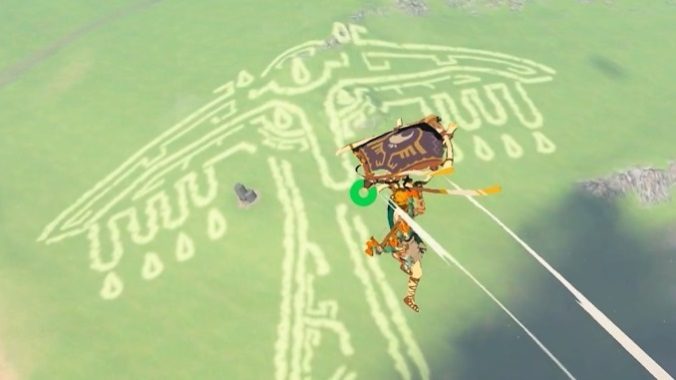My favorite thing in Breath of the Wild is Zelda’s camera roll. When Link obtains the Sheikah Slate, the sci-fi MacGuffin that serves the same role as Tears of the Kingdom‘s Purah Pad, and which unlocks most of the game’s abilities, included on it are a set of 12 photographs, taken by the princess herself. These photos are of various locations in the game’s world. If you find the location where the picture was taken, you will unlock a related cutscene. Link has lost his memories and these photographs are the trailheads to his restored mind.
In many open world games, tracking locations is simply a matter of map markers and GPS. In Breath of the Wild, finding these photographs requires a holistic understanding of the world and how its various places relate to each other. For the vast majority of the photos, you can approximate the location where it was taken just by looking at it. This clarity makes looking for the pictures a brain teaser with bite. You could just look up a guide to find each location, but the ease with which the approximate destination can be identified makes it joyful to just explore.
No other game (that I’ve played anyway) gets this idea quite right. Some of Far Cry 6‘s quests ask you to find a location from a photo on your phone, but that Ubisoft paradise is far flatter and less identifiable, making looking for landmarks feel like an endless chore rather than an itch in the back of your mind. Elden Ring’s iteration fares better, in which you find the locations where various landscapes were painted. Similar to Breath of the Wild, its world is built around iconic locations, allowing players to look for the paintings intuitively. But without the tie to an intimate prior relationship, it lacks any emotional energy. It’s simply another one of Elden Ring‘s many little tasks.
Of course, there are many fantastic games about taking pictures, like Umurangi Generation and Sekiro, but there are far fewer about the strangeness of holding a picture you did not take, but that you see yourself in—a portal to a world that did exist, but doesn’t anymore. The photographs are not the only way Breath of the Wild paints with the brushes of history and memory. The game recreates locations from past entries in the series, carefully quotes leitmotifs, and even places itself as both the end and beginning of every prior legend. The photographs are the most direct connection to the past, but they are also the most emotional.
In some sense, Breath of the Wild is about a large-scale failure that resonates not just throughout that game but through Tears of the Kingdom as well. Zelda and Link are unable to prevent Ganon’s rise to power. Zelda, alone, can contain it in an act of genuine heroism (also emblematic of the series’ structural misogyny, she can contain Ganon but cannot kill him). The arc of the past is tragedy; the world-as-it-was has ended. Link walks through its ruins. Ultimately, of course, the memories are affirming of Link’s ultimate destiny, the promise that he will restore the glory of Hyrule. This failure and Zelda’s imprisonment were temporary fates, written in the stars. However, though Breath of the Wild‘s plot tries to give these memories the impact of grand design, they feel more like the quiet aches of heartbreak. Then, you had a fellowship, a band of people dedicated to protecting what you loved. Now, all your friends are dead and you must fight alone, with only spirits and voices to guide you.
Tears of the Kingdom keeps the basic threads of this concept: memory cutscenes connected to specific locations on the map. However, the memories are no longer associated with photographs, but with gigantic geoglyphs carved into the landscape. Rather than identify a specific location, you must find the exact spot on the geoglyph’s lines where a memory pool can be found. Scaling the length of a geoglyph to find the spot that will activate a memory is simple pixel-hunting. It’s more archaeology than sifting through polaroids.
This is dreadfully boring. Both the delightful puzzle and the teasing melancholy of the previous system are gone, replaced with a simple easter egg hunt for story details. One could make the argument that for a game so directly about unearthing the physical past, these geoglyphs better serve its themes. But Tears of the Kingdom already has plenty of this kind of archaeological history. The sky islands, fragments of which fall from the heavens, the previously unexplored depths, and literal rifts in the ground from which the far distant past emerges populate the game’s crowded landscape. If there’s something the game could use more of, at least in my limited time with it, it’s the quiet, mournful sensation that Breath of the Wild could sometimes conjure.
It’s not entirely without that melancholy. I teared up in an early cutscene when Link makes a temporary connection to the past. I am intrigued by Tears of the Kingdom‘s relationship with the distant past of Hyrule, by the nature of Link’s curse, and by how the game will bring in the wider mythos of the series. At least right now, though, none of that feels as important as the simple recognition of the past, a tearful goodbye to a time that was, but will never be again.
Grace Benfell is a queer woman, critic, and aspiring fan fiction author. She writes on her blog Grace in the Machine and can be found @grace_machine on Twitter.
